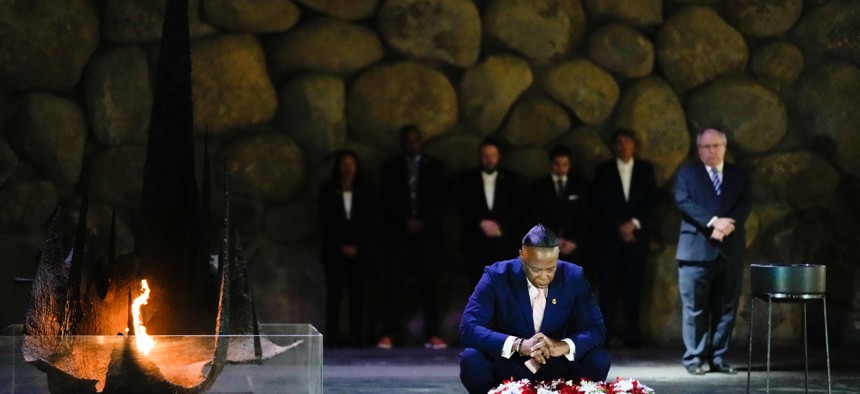News & Politics
Adams’ Israel trip follows a tradition of mayoral journeys abroad to drum up political support back home
Ireland and Italy were big destinations in the past, followed by Puerto Rico and the Dominican Republic.

New York City Mayor Eric Adams visits Yad Vashem in Jerusalem, where he laid a wreath in the Hall of Remembrance, on the second day of a 3-day visit to Israel on August 22, 2023 (Michael Appleton/Mayoral Photography Office)
It’s been described as both a time honored tradition and a rite of passage. Like a long line of his predecessors, New York City Mayor Eric Adams traveled to Israel this week for what he’s pitched as a chance to meet with leaders to learn about Israeli technology, visit religious sites, and discuss joint efforts to combat antisemitism.
For someone like Adams, whose base includes many Orthodox Jews and evangelical Christians, the three-day trip to Jerusalem and Tel Aviv is a high-profile opportunity for him to show solidarity and strengthen relationships with a large and powerful Jewish constituency back in the city. It’s also a chance for Adams to try and drum up additional political support, though some critics argue the trip’s existence doesn’t reflect the diverse spectrum of opinions in New York City’s Jewish communities. Another justification? The potential economic and recruitment opportunities of showcasing the city overseas, according to Basil Smikle Jr., director of the Public Policy Program at Hunter College.
Traveling to Israel as a New York mayor is nothing new. Every mayor going back at least as far as 1980 when Ed Koch made his first trip, has visited on political business and each trip has sparked at least a measure of controversy. While Adams was expected to attend a reception with Israeli faith leaders in Jerusalem Monday evening, his plans also included meeting Israeli Prime Minister Benjamin Netanyahu Tuesday – a meeting that comes amid Netanyahu and his far-right government’s controversial push to overhaul the country’s judicial system, the Daily News first reported.
But while Israel has remained a trademark destination for New York City mayors going on four decades now, the breadth of countries visited by the city’s top officials has broadened and evolved in a way that mirrors much of the city’s demographic trends, according to Democratic political strategist Hank Sheinkopf. As the city has grown more ethnically diverse, so too have mayors’ travel itineraries, he said, explaining that historically, mayors and other New York City elected officials tended to travel abroad based on the “three I’s.”
“Israel, Ireland and Italy were the places where mayors or candidates went for citywide offices in New York because they were more reflective of the nature of the population in those years,” Sheinkopf said. “Now that’s changed.”
A CUNY report for the city’s Districting Commission published earlier this year found that Dominicans, African immigrants, and Asians accounted for more than half of the city’s net growth of 629,415 people over the last decade.
“Going to the Dominican Republic is a very big thing and everybody goes to Puerto Rico in November for Somos, which is part of the mayoral jaunting,” Sheinkopf said. “You are probably going to see mayors in the next few years spend more time in the Caribbean overall. The population of the city has shifted and it won’t be long before mayors are going to Mumbai and to places where Bengali, Urdu, and Hindi are spoken … as well as Africa.”
Over a year into his tenure, Adams’ foreign trips include the most recent one to Israel, a four-day journey to Greece and Qatar in December 2022, and the Dominican Republic – first to meet with political leaders and second to survey the damage left in Hurricane Fiona’s wake.
There’s a lot of political calculus that go into the decision making of where New York mayors go for foreign trips. During his time working for former Mayor Michael Bloomberg, Chris Coffey, CEO of Tusk Strategies, said he remembers a meeting where the team discussed some of the city’s biggest emerging ethnic communities, Haitians and Albanians – Bloomberg went on to visit both Haiti and Kosovo.
Beyond the potential political benefits of Adams’ going somewhere important to a swath of his base, he said it’s respectful for a mayor to go to different countries that have historical ties with New York and to relay the city’s support for those places. Whether his goals will actually translate into more support from the Jewish community at home however is hard to say.
“It’s not like it’s a recipe where you add two cups of flour and more cups of sugar and that’s how you get the thing,” Coffey said. “Does it actually help get him votes? There’s always been a long standing debate. Are you better off working the room in Williamsburg and the Upper West Side or do you spend that time in Israel? What mayor’s have historically said is if they are big communities in New York, if they matter a lot to you in your voting bloc, you probably do both.”
NEXT STORY: Who’s running in NY-18?

